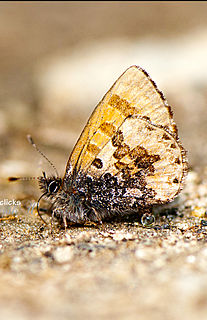
Orthomiella pontis, the straightwing blue, is a small butterfly found in India that belongs to the lycaenids or blues family.

Hypolimnas misippus, the Danaid eggfly, mimic, or diadem, is a widespread species of nymphalid butterfly. It is well known for polymorphism and mimicry. Males are blackish with distinctive white spots that are fringed in blue. Females are in multiple forms that include male-like forms while others closely resemble the toxic butterflies Danaus chrysippus and Danaus plexippus.
Spilosoma rostagnoi is a moth in the family Erebidae. It was described by Charles Oberthür in 1911. It is found in Sichuan, China.
Helcystogramma juventellus is a moth in the family Gelechiidae. It was described by Walsingham in 1897. It is found in Jamaica and Mexico (Tabasco).
Chionodes terminimaculella is a moth in the family Gelechiidae. It is found in North America, where it has been recorded from south-western Quebec to southern British Columbia and to Colorado and Massachusetts.
Chionodes bufo is a moth in the family Gelechiidae. It is found in Mexico (Guerrero).
Recurvaria sticta is a moth of the family Gelechiidae. It is found in Mexico (Guerrero).
Telphusa ochrifoliata is a moth of the family Gelechiidae. It is found in Mexico (Veracruz).
Filatima depuratella is a moth of the family Gelechiidae. It is found in North America, where it has been recorded from Arizona and New Mexico.
Compsolechia erebodelta is a moth of the family Gelechiidae. It was described by Edward Meyrick in 1922. It is found in Peru.
Compsolechia ambusta is a moth of the family Gelechiidae. It was described by Walsingham in 1910. It is found in Mexico, Brazil, Colombia and Peru.
Compsolechia glaphyra is a moth of the family Gelechiidae. It was described by Walsingham in 1910. It is found in Mexico.
Compsolechia metadupa is a moth of the family Gelechiidae. It was described by Walsingham in 1910. It is found in Mexico (Tabasco).
Compsolechia titanota is a moth of the family Gelechiidae. It was described by Walsingham in 1910. It is found in Guatemala.
Compsolechia zebrina is a moth of the family Gelechiidae. It was described by Walsingham in 1910. It is found in Mexico (Tabasco).
Compsolechia salebrosa is a moth in the family Gelechiidae. It was described by Edward Meyrick in 1918. It is found on the Galápagos Islands and in Colombia and Guyana.
Compsolechia nuptella is a moth of the family Gelechiidae. It was described by Cajetan Felder, Rudolf Felder and Alois Friedrich Rogenhofer in 1875. It is found in Peru and Amazonas, Brazil.
Compsolechia peculella is a moth of the family Gelechiidae. It was described by August Busck in 1914. It is found in Panama.
Stomopteryx deverrae is a moth of the family Gelechiidae. It was described by Walsingham in 1905. It is found in Algeria and Spain.
Aristotelia pyrodercia is a moth of the family Gelechiidae. It was described by Walsingham in 1910. It is found in Mexico (Guerrero).

